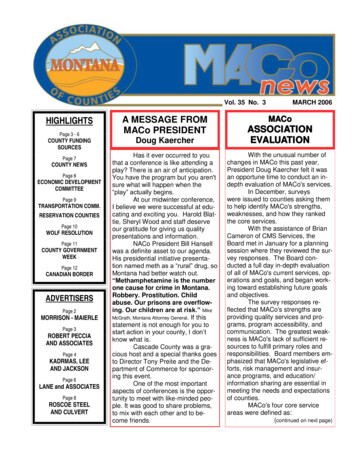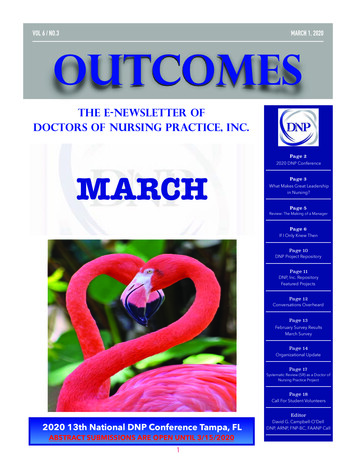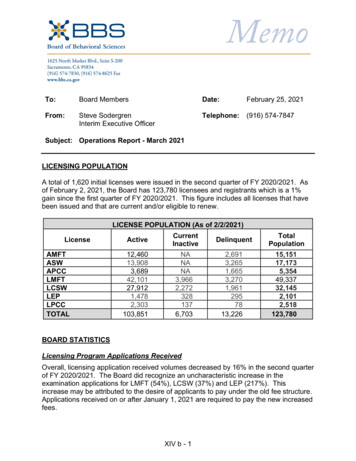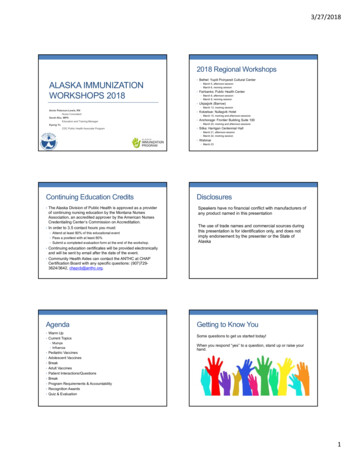
Transcription
Vol. 35 No. 3HIGHLIGHTSA MESSAGE FROMMACo PRESIDENTMARCH 2006MACoCOUNTY FUNDINGSOURCESDoug KaercherASSOCIATIONEVALUATIONPage 7Has it ever occurred to youthat a conference is like attending aplay? There is an air of anticipation.You have the program but you aren'tsure what will happen when the“play” actually begins.At our midwinter conference,I believe we were successful at educating and exciting you. Harold Blattie, Sheryl Wood and staff deserveour gratitude for giving us qualitypresentations and information.NACo President Bill Hansellwas a definite asset to our agenda.His presidential initiative presentation named meth as a “rural” drug, soMontana had better watch out.“Methamphetamine is the numberone cause for crime in Montana.Robbery. Prostitution. Childabuse. Our prisons are overflowing. Our children are at risk.” MikeMcGrath, Montana Attorney General. If thisstatement is not enough for you tostart action in your county, I don’tknow what is.Cascade County was a gracious host and a special thanks goesto Director Tony Preite and the Department of Commerce for sponsoring this event.One of the most importantaspects of conferences is the opportunity to meet with like-minded people. It was good to share problems,to mix with each other and to become friends.With the unusual number ofchanges in MACo this past year,President Doug Kaercher felt it wasan opportune time to conduct an indepth evaluation of MACo's services.In December, surveyswere issued to counties asking themto help identify MACo's strengths,weaknesses, and how they rankedthe core services.With the assistance of BrianCameron of CMS Services, theBoard met in January for a planningsession where they reviewed the survey responses. The Board conducted a full day in-depth evaluationof all of MACo's current services, operations and goals, and began working toward establishing future goalsand objectives.The survey responses reflected that MACo's strengths areproviding quality services and programs, program accessibility, andcommunication. The greatest weakness is MACo's lack of sufficient resources to fulfill primary roles andresponsibilities. Board members emphasized that MACo's legislative efforts, risk management and insurance programs, and education/information sharing are essential inmeeting the needs and expectationsof counties.MACo's four core serviceareas were defined as:(continued on next page)Page 3 - 6COUNTY NEWSPage 8ECONOMIC DEVELOPMENTCOMMITTEEPage 9TRANSPORTATION COMM.RESERVATION COUNTIESPage 10WOLF RESOLUTIONPage 11COUNTY GOVERNMENTWEEKPage 12CANADIAN BORDERADVERTISERSPage 2MORRISON - MAIERLEPage 3ROBERT PECCIAAND ASSOCIATESPage 4KADRMAS, LEEAND JACKSONPage 6LANE and ASSOCIATESPage 8ROSCOE STEELAND CULVERT
MACo EVALUATION AND PLANNINGCONTINUEDMARK YOUR CALENDARMarch 4 - 8March 8March 9March 9-10March 10March 131) legislation and policy, 2) education and information sharing, 3) meetings and conferences,and 4) publications.Service goals include:1) Pursue alternative funding sourcesincluding sponsorships, grants and optional feebased products and services to provide revenues for program enhancement2) Promote interaction between electedofficials through meetings and networking opportunities3) Provide information to the membership by enhancing the newsletter to includemore in-depth county information.4) Updating and promoting MACo publications, including having them available fordownload from the website5) Improve technology to provide interactive web relay chats on specialized topics suchas roads, subdivisions, etc., and a FAQ sectionfor counties to research and share informationand resources. Provide centralized technologysupport services to counties.March 23NACo Annual Legislative Conference, D.C.MACo Congressional Breakfast; DC; 8:30 amWeed Meeting; CapitolInterim Finance Committee; Capitol Rm. 102HJR 11 Meeting; Capitol; 10:00 amMACo Executive Committee, ConferencePlanning and Education CommitteesLast day to file for county officesUPCOMING SCHEDULEApril 3-6MACRS Convention; Great FallsApril 7-9National Coalition of Forest Counties; RenoApril 5-7Co. Superintendents of Schools; FairmontApril 18-19Joint JPA / JPIA Trustees MeetingApril 23-27Magistrates Convention; MissoulaWHAT DO YOU KNOW ABOUTMONTANA COUNTIES?Recently, the 7th and 8th grades in Cardwell Schoolsubmitted a series of questions about Montana Counties. They used the MACo website to develop theirquestions.Submitted by Kellee Glaus and Amy ReavisCardwell 8th grade1. What are the names of the county commissioners in Wheatland County?2. How many new fire trucks have been addedto the Sweet Grass fire department?3. What is the population of Fallon County?4. What is the county seat of Ravalli County?5. What is the size of Roosevelt County insquare miles?6. What three counties border Toole County?7. What county makes up the “nose” ofMontana?8. What county is north of Mineral County?9. In what county is the Cardwell School?10. What is the address for Missoula County’scourthouse?11. What is the county seat of McCone County?12. How many men are county commissioners inButte-Silver Bow County?A general outcome of the survey and theplanning session was the realization that Association management and staff do a great job withthe resources that are available. As needs forservices grow, we must pursue alternative funding sources to be able to provide the increasinglevels of services.MACo's management and staff thank theBoard for their continued support and guidanceand encourage the membership to contact theoffice for information and/or assistance.PLEASE SUPPORT MACo SUPPORTERS(answers are found on page 11)2
NOTICE: The following pages contain selectionsfrom information which was to be presented at acancelled session for Commissioner CertificationTraining during Midwinter Conference. PLEASE NOTETHE APPLICATION DEADLINES.Jim Edgcomb and Gus Byrom from Departmentof Commerce kindly submitted their presentation.FUNDING OPPORTUNITIES FORCOUNTY PROJECTSCommunity Development Block GrantTreasure State Endowment ProgramMontana Department of CommerceGrants must principally benefit low andmoderate income (LMI) families ( 51%).Montana Department of CommerceFunding for systems for drinking water, wastewater treatment, sanitary, storm sewer and/or solidwaste and bridges1) Planning Grants(Housing and Public Facilities)1) Grants for Preliminary Engineering Maximum amount 15,000 with for match Priority given to first-time applicants Applications from 2005 grants will beprocessed June 1, 2006Apply for preliminary engineering grants afterJanuary 1, 2007.Applications due April 21, 2006 for FFY 2006 grantsat 15,000 maximum each with for match.Grants can be used for: Growth Policies (Comprehensive Plans) Needs Assessments Income and/or Housing Surveys Grant Writing Engineering and/or Architectural Studies2) Grants for Emergency Projects Maximum amount 30,000 Must be a true EMERGENCY2) Public Facility GrantsApplications due May 26, 2006 for FFY 2007 grantsat 450,000 maximum each.Grants can be used for: Basic infrastructure improvements (water,wastewater, solid waste facilities) Facilities designed for use predominantly byLMI persons – such as nursing homes,senior centers, Head Start centers, ruralhospitals, or mental health centers3) Grants for Construction Projects Applications accepted every other year 750,000 limit per project with for match Limit of 15,000 per householdApply for construction grants before May 5, 2006.Contact Jim Edgcomb 841-2785 or jedgcomb@mt.govForms are at http://comdev.mt.gov/CDD TSEP.aspPLEASE SUPPORT MACo SUPPORTERS3) Housing & Neighborhood Renewal GrantsApplications due Nov. 3, 2006 for FFY 2007 grantsat 450,000 maximum each.Contact Gus Byrom 406-841-2777 or gbyrom@mt.govForms are athttp://comdev.mt.gov/CDD CDBG.asp4) Economic DevelopmentOpen Cycle for ApplicationsContact Karyl Tobel406-841-2733 or karylt@mt.govForms can be found at:http://businessresources.mt.gov/BRD CDBG.asp3
FUNDING OPPORTUNITIES FORCOUNTY PROJECTS, Part 2Rural DevelopmentLoan & Grant ProgramDW & WPCState Revolving Funds For communities less than 10,000 populationLoans can be re-paid over 40 years.Community facilities programs includeguaranteed loans, direct loans and grants.All three can be combined on the same projectdepending on financial strength of theorganization and project.No Deadlines - Can Apply at AnytimeBe on Priority List & Intended Use PlanLow Interest Loans - Currently 3.75%20 Year TermFor more information contact:Mark Smith, Drinking Water SRF406-444-5325 or marks@mt.govPaul LaVigne, Pollution Control SRF406-444-5321 or plavigne@mt.govWebsite http://deq.mt.gov/wqinfo/srf/index.aspContact Mitch Copp406-585-2520 or mitchel.copp@mt.usda.govRenewable ResourceGrant & Loan ProgramCoal Board GrantsMontana Department of CommerceMontana Department of Natural Resources& Conservation Assists with mitigating local impacts createdby large scale coal development or decline Includes coal-fired plants Total available per year - 1.5 to 1.9 million Board meets quarterly Criteria - need, severity of impact, availabilityof funds, degree of local effort 100,000 - Renewable Resource Grants 4,000,000 Available Each Biennium 10,000 - Preliminary Engineering Studies 30,000 - Emergency Grants Loans Limited by Ability to Repay in 20 YearsApplication deadline is May 15, 2006For information contact Joe LaForest406-841-2789 or jlaforest@mt.govWebsite http://comdev.mt.gov/CDD CB.aspFor information contact:Bob Fischer, at 406-444-6688 or rfischer@mt.govPam Smith, at 406-444-6839 or pamsmith@mt.govWebsitehttp://dnrc.mt.govPublic Works GrantsPLEASE SUPPORT MACo SUPPORTERSEconomic Development Administration Water and sewer systems Historically, 3 to 5 million available peryear for all projects Generally, grants do not exceed 1 million Project must be tied to economic development, with actual jobs created Eight ranking criteria with emphasis oneconomic distress and job/cost ratioFor information contact John Rogers406-449-5380 or jrogers@eda.doc.gov4
FUNDING OPPORTUNITIES FORCOUNTY PROJECTS Part 3Water Resources Development Act(WRDA) Grants U.S. Army Corps of Engineers Provides grants for water related projectsin rural Montana including:Environmental infrastructure projectsResource protection projects 75% / 25% cost share Typically no more than 1,500,000 Limited time frame to spend funds Apply through Congressional delegation For information contactEd Haffke, U.S. Army Corps of Engineers402-221-3666 or edward.o.haffke@usace.army.mil Other Funding ns.aspPreservation Assistance GrantsPublic Lands HighwayDiscretionary ProgramFHA Emergency Relief for Federal RoadsFederal Emergency Management AgencyLocal Option Motor Fuel Excise Tax (up to2 by initiative or resolution / referral)Optional Motor Vehicle Tax (by election)Debt Financing Methods Rural Improvement Districts General Obligation BondsU.S. Air Force (if bridge is on a primaryroute to a missile site)GRANTSWORKSHOPSRural Water DevelopmentBureau of ReclamationGrant planning workshops for water,wastewater, and solid waste projects will be heldMarch 2nd at the Holiday Inn in Missoula, andMarch 7th at the Sheraton Hotel in Billings.The workshops start at 8:30 a.m. and are scheduled to adjourn at 4:00 p.m. The workshops arefree and pre-registration is not required.The workshops are sponsored by Water,Wastewater and Solid Waste Action CoordinatingTeam (W 2ASACT) and the Department of NaturalResources and Conservation (DNRC), in conjunction with the Board of Investments, the Department of Commerce, the Department of Environmental Quality, and the U.S. Department ofAgriculture.The workshops will focus on the fundingprograms available to communities looking to upgrade their water and wastewater and solid wastesystems. These programs include the RenewableResource Grant and Loan Program, the TreasureState Endowment Program, the State RevolvingFund Loan Programs, the Rural DevelopmentProgram, and the INTERCAP Program.For more information visit the W 2ASACTwebsite at http://dnrc.mt.gov/cardd/ or contactDNRC at 406-444-2074.Grants for drought related water developmentWater development projectsWater conservation projectsNo match requirementNo limits, but typically no more than 150,000For information contact Rick DeVoreGreat Plains Regional Office in Billings406-247-7757 or RDEVORE@gp.usbr.govVariable Rate Loan ProgramMontana Board of Investments Apply anytime - Money always available Last year’s rate: 3.8% Average Rate for past 10 Yrs: 4.16% Loan term – 10 years Loan for preliminary engineering Interest only for 3 years No up-front costs Prepayment without penaltyCall Louise Welsh – 444-08915
IN MEMORIAMKEEPING RECORDS:WHY IT’S IMPORTANTBy Kathy McGowan, Executive DirectorMontana Sheriff & Peace Officers Assoc.OTTO JOSEPH JENSENOtto Jensen, 78, former FergusCounty Commissioner, died inJanuary. Jensen served seventeenyears as commissioner, from January 1969 through 1986. He hadspecial interest in mental healthissues and was particularly activewith the Council on Aging and theFergus County fairs. He served asMACo Second and First Vice President.His wife, Betty, and threechildren and their families survive.His son, John, currently serves as aFergus County Commissioner.Several weeks ago Sheriff’s Offices were askedto submit data to the Montana Sheriffs and PeaceOfficers Association (MSPOA) office regardingthe cost of transporting their mentally ill residents.We received no responses at all from somecounties, estimates from others, specific datafrom some and admissions from others that thisdata was not collected.So what’s the big deal? The Montana Associationof Counties, with the support of MSPOA, amongothers, is attempting to find alternatives and solutions to this mental health issue, among others.Meetings with the Addictive and Mental DisordersDivision and with legislative committees have resulted in some interest in these issues. However,anecdotal information, wringing of hands, andwiping of brows isn’t sufficient. They want somehard numbers in terms of what the costs reallyare.IN MEMORIAMWe will not be asking again for this particular information, at least not in the near foreseeablefuture. The purpose of this article is not to pointfingers, not to chastise, but simply to remindfolks that we only are as powerful as the good,reliable information we can produce. It need notbe complicated. In this case it can be as simpleas logging trips, applying a formula of X foremployee time and X for mileage.KAY KIRK BECKKay Beck, 65, former Powell CountyCommissioner, died February 17after a short illness. She was appointed to the commission in January 1998 and served through 2002.She was active on the MACo Information Technology Committee.PLEASE SUPPORT MACo SUPPORTERSBeck was an accomplished musician and artist. She specialized inthe harp, watercolors and craftedpaper arts. She is survived by herthree children, their families and former husband, Tom, who served onthe Powell County Commission andwas MACo President in 1985.6
COUNTY NEWSMENTAL HEALTH COSTSSURVEY RESPONSESHave you submitted your responsesfor the mental health cost survey?23 out of 56 counties haveresponded but we need a morecomplete report. MACo is compilingthis information for a presentation tothe Children, Families, Health & Human ServicesInterim Committee on March 30.STAFF AND FACILITIESSTILLWATER and CARBONCOUNTIES are considering sharing a compliance officer or misdemeanor probation officer position.POWDER RIVER COUNTY Manorcontinues it’s recruiting efforts fornurses and has increased hourlyrates to 21 for CNAs, 31 forLPNs and 38 for RNs.CASCADE COUNTY combined 28city polling places into 17 in preparation for a May 2 school boardelection.FLATHEAD COUNTY rescindedits new requirement that JusticeCourt judges be licensed attorneys. No legal reference could befound to allow this requirement.STILLWATER COUNTY purchased vacant commercial property to house the county attorneyand support staff. The Countyhoped to alleviate rental payments.GRANITE COUNTY plans to beginusing a mothballed electrical generation plant, which was closed in1990 and sold to the County for 1.A Bozeman company won the bidto begin operation as soon as Federal approval is granted.DAWSON COUNTY has receivednine separate options for improvingenergy efficiency in the courthouse. Following an energy audit,recommendations included retrofitting lighting fixtures, upgrading theboiler system, replacing the emergency generator, adding temperature controls, replacing controlvalves for heating and cooling, upgrading the fire alarm system andplanning for regular maintenance.Each recommendation can be implemented and paid for separately.NEW OFFICIALPETROLEUM COUNTY’s newSheriff is John W. Taylor.LAND USEFLATHEAD COUNTY, for the 11thtime in two years, has prevailed ina land use planning lawsuit relatingto a gravel pit and a nearby residential area.MISSOULA COUNTY’s plan for acounty-wide open-space bond isopposed by a group of Swan Valley residents who fear higher property taxes to “subsidize conservation easements”. Meanwhile 6,000acres in Swan Valley have recentlyreceived a conservation easementdesignation using federal funding.7FOR SALERosebud County is acceptingsealed bids for the sale of oneused 1983 Caterpillar 140G roadgrader, VIN# 72V6954. Bids willbe opened at the CommissionersOffice on March 15th, 2006 at10:00 a.m. Minimum bid of 32,000.00 required. 346-22612006 DIRECTORY ADDITIONSTREASURE COUNTYCommissioner Mack Cole emailcolemj@rangeweb.netBUTTE-SILVER BOWCommissioner Wally Frasz emailwfrasz@bresnan.netCHOUTEAU COUNTYClerk of Court Larry Stollfuss emaillstollfuss@mt.govWHEATLAND COUNTY’s newcentral phone number is 632-4891,with the corresponding extensions:CommissionersExtension 301Clerk and RecorderExt. 301Clerk of CourtExt. 315Justice of PeaceExt. 307School SuperintendentExt. 306TreasurerExt. 302
MACo COMMITTEE REPORTSJoe McClure believes we need to be vigilant about Wrongful Discharge Laws becausethey may get worse before they get better. TheCommittee needs to take an active role alongwith MACo.Lance Olson, representing the Resolutions Committee, alerted us regarding streamaccess at county bridges, and issue which maybe passed on to the Committee.Tony Preite, Department of CommerceDirector, commended the group on their effort todevelop good relationships and share limited resources. He also discussed the Department ofLabor / Department of Commerce’s successfuljoint grant application for economic development dollars ( 15,000,000 over a 3 year period).Other economic development district funds whichwere recently recognized but not funded will receive some funding ( 50,000 – 53,000/ year)and access to additional trust funding.ECONOMIC DEVELOPMENTsubmitted by Cynthia Johnson, Pondera CountySheryl Wood reported on Department ofCommerce’s efforts to decommission mobilehomes in order to expedite transfer to landfillsites. Issues include asbestos testing and mitigation, appropriate disposal of appliances and fixtures, funding and potential for meth labs sites.Joe McClure, Big Sky Economic Development Association, briefly reported on legislativeactivities and efforts being explored by MEDAincluding Micro-business Program, Local Option Tax, and Incumbent Worker Training.There is potential to lift the ceiling on resort taxesto allow each community to set its own rate. Thiscould be a form of local option tax. Holding Federal Unemployment Taxes for a longer periodcould generate interest income for IncumbentWorker Training.Charles Brooks, representative of Yellowstone County, reminded us of the importance ofpursuing methane gas development. MackCole reported that the Board of EnvironmentalReview is considering a couple of proposals fromthe Northern Plains Resource Council, whichwould devastate methane gas production. Herecommended that the Committee to work to defeat these proposals. Mack will draft languagefor a letter of support, petition and resolution forthe promotion of methane gas production. AdamGartner believes a big effort needs to be made toeducate the public about the benefit of methanegas production.LEGISLATIVE ISSUES1. Bridges – public access; Committee will workwith MACo Public Lands and TransportationCommittees2. State of Art Repository – Issue dead3. State Sales Tax --John Jensen will contactState Representative Peterson.4. One Stop Shopping for financial informationand assistance – Mack Cole reported he hasdiscussed the issue with MACo staff and theyare considering possible solutions.PLEASE SUPPORT MACo SUPPORTERSROSCOE STEEL & CULVERT5. Taxing Conservation Easements using thevalue of the property right--no action but willfollow the issueThe Most Reliable Source of ProductsRequired for County Road Projects6. Frivolous Lawsuits -- no action; will use another route to resolve406 / 656-22532847 Hesper RoadBillings, MT 591027. Property class 15 for waste area management -- proposed legislation is coming406 / 542-03455405 Momont RoadMissoula, MT 598028. Incumbent Worker Training – Issue dead8
MACo COMMITTEE REPORTSTRANSPORTATION COMMITTEERESERVATION COUNTIESJohn Ostlund, Chair, Yellowstone CountySubmitted by Cynthia Johnson, Pondera County1. Resolution to increase the cap for CountyRoad and Bridge Capitol Fund over 500,000Some stand-alone bridge projects cost over thatamount and each piece of new equipment maycost several hundred thousand dollars.MOU for Reservation Roads: The escape clauseincluded by Sara Bond, Governor’s office, andapproved by Chair Gary Macdonald has madethe agreement complete.2. Montana Code 7-14-2205: This requires amunicipality to go to the voters for a bridge thatcosts more than 10,000. We need to clean thisup since Counties are responsible for all bridgeconstruction even in incorporated cities.Questions1) If the county signs the MOU with the BIA anda tribe splits with the BIA to manage its ownroads, can a county enter an MOU with thetribe?Yes2) Is the BIA the initiating agency to submit theroads for the inventory?Yes.3. County owned Fuel TanksEach individual County will need to address therequirements for bulk fuel deliveries and storage.4. Clear fuel requirements will be addressed inin our bidding process. (previous MACo email)The BIA receives funds in each state, but tribescould enter into 638 agreements to receive thosedollars in a lump sum for transportation. Thefunds addressed in each agreement must beused for the purpose intended.5. The Theodore Roosevelt ExpresswayConcern from the Eastern Counties that this highway route will by-pass eastern Montana led todiscussion with congressional staff. ConradBurn’s office will look into this issue.6.Contracts for Bridge & Highway ProjectsThe county contracts with MDOT need to followbest management practices and manage the siltfencing after completion of an off system or secondary road project. Many counties feel theymust sign the contracts or lose the projects.Chairman Macdonald shared the inventory process being undertaken by Roosevelt County.Gary Hall distributed a copy of Lake County’sagreement with Kootenai-Salish Tribes as an example of what the second stage of a road inventory agreement would look like for constructionpurposes.7. SB 222: Several suggested that diesel fuel beadded to the allowable 2 local option fuel tax tofund Road / Bridge departments. Likely the trucking industry would view this as a pass throughand it could be a struggle in the legislature.The motion to approve the MOU for use by Reservation Counties regarding Road InventoryAgreement was seconded and carried.8. RSIDs: Not only can 51% of the residentsprotest out of a RSID, but there may also be away for over 50% of the property valuation to protest out. (HB 431 changed previous methods.)Chair Macdonald will report to the Rocky Mountain Great Plains Transportation Regional Meeting that Montana Reservation Counties agreed touse this format to enter into road inventory agreements with reservations.9. Reservation Road Inventory AgreementThe reservation counties have agreed that thisagreement can be signed by individual counties.It will allow the BIA to inventory all county roadson the reservations for a separate source of funding that will not affect gas tax allocation or reflectin the transportation bills.Chair Macdonald discussed bridge funds available for bridge maintenance on reservations. Apparently, engineering costs are now included andinterested parties should contact their appropriateBIA office.9
RISK ASSESSMENTMACo COMMITTEE REPORTSPUBLIC LANDSEmelia McEwenMACo Risk Management AssistantRESOLUTION TO SUPPORT THE JOINTRESOLUTION TO AFFIRM THE GRAY WOLF APREDATOR SPECIES IN NEED OF MANAGEMENT IN BEAVERHEAD, CARBON,GALLATIN, MADISON, PARK, STILLWATER,AND SWEET GRASS COUNTIESBy performing musculoskeletal disorder(MSD) risk assessments in the workplace, countydepartments can make ergonomic changes before the risks turn into costly injuries and workerscompensation payments. An assessment looksat body risk factors such as job tasks and workstations and, ultimately, will help identify whomay be at risk for injuries.To perform a risk assessment, focus onhow many job tasks are used in a job, assessingone task at a time. If too many tasks are scoredat once, everything will be scored as high risk.Watch an employee’s entire body during work toidentify the forces and weights the worker mustovercome. Posture, force and repetition havebeen identified as the leading causes of MSDs.Be sure to quantify the duration of a task, as wellas the repetition.What risks do you see? Is the worker’sbody angle locked in a static posture for morethan 20 seconds at a time? Are the elbowsabove shoulder height?What injuries would you expect to see inthe job? Seated computer workers tend to lungeforward while they work. This puts stress on theirneck and shoulders, creating muscle fatigue. Isthere contact with hard surfaces with the hands,wrists, legs or waist?What is the duration or frequency? Repetitive motion tasks which are performed severaltimes per day will have a higher risk than occasional tasks.What is the cost to abate the risk?How many workers perform the task?Once the risks are identified, changes canbe made to improve employee health:Alter schedules: Consider moving schedules to reduce heavy cycles on any one dayEliminate productivity incentives: Workersmay take unnecessary risks in an effort to increase production to earn incentives.Implement job / task rotation: Allow workers to change job tasks during their workdays. Ifthe job requires a copious amount of standing,consider alternating some desk tasks during thework day.WHEREAS, the Public Lands Committeeof the Montana Association of Counties hasvoted unanimously at their February 2006 meeting to support the joint resolution presented onbehalf of the above counties; andWHEREAS, Montana livestock producershave suffered substantial losses due to predationby wolves; andWHEREAS, a working group of Montanacitizens and agencies has developed the Montana Livestock Loss Reduction and MitigationProgram, which has generated a reimbursementprogram for losses caused by gray wolves, yetthe program does not yet have a Board or sourceof funding;NOW, THEREFORE, BE IT RESOLVEDthat the Public Lands Committee of the MontanaAssociation of Counties joins in support of thejoint resolution between these counties and insupport of efforts made in seeking fundingthrough appropriations for the Montana LivestockLoss Reduction and Mitigation Program and themanagement of gray wolves.SIGNED AND DATED this 16th day ofFebruary 2006 at the Midwinter meeting of theMontana Association of Counties.Connie Eissinger, ChairMACo JPIAProperty & Casualty Insurancefor Public EntitiesGreg JacksonMarketing DirectorPhone (406) 444-4370Fax (406) 442-5238Email: macoim@maco.cog.mt.us10
NACo INFORMATION5RESTORATION GRANTNACo and the Five Star Restoration Challenge Grant Program are accepting applicationsfor the 2006 Five Star Restoration ChallengeGrants. The Five Star Program provides modestfinancial assistance on a competitive basis tosupport wetland, riparian and coastal habitat restoration projects that foster local natural resourcestewardship through education, outreach andtraining activities. The Five Star RestorationChallenge Grant Program is a partnership between NACo, National Fish and Wildlife Foundation and the Wildlife Habitat Council, with supportfrom the Environmental Protection Agency--EPA.In 2005, 53 projects received grants averaging 10,000 each. In Montana, Cascade Countywas awarded funds for the Lower Sun River Restoration Project and Flathead County wasfunded for the Vo-ag Center Streambank Preservation Project.The deadline for applications is March 10.For more information visitwww.naco.org/techassistance or contactErik Johnston at 202-942-4246 orejohnston@naco.orgGet Ready for NationalCounty Government WeekApril 23–29National County Government Week is justaround the corner.This year's themeProtecting Our Communitiessets the stage for a special focus on all the wayscounties work to protect their residents from theimpact of natural disasters, terrorist attacks,crime, and drug abuse.Go to www.naco.org for suggestions andideas for your county to use to celebrate.MONTANA COUNTIES--ANSWER KEY1. Tom Bennett, Richard Moe, and DavidMiller2. One3. 2,774 people4. Hamilton5. 2,386 sq. miles6. Glacier, Pondera, and Liberty Counties7. Ravalli County8. Sanders County9. Jefferson County10. 200 West Broadway, Missoula, Montana11. Circle12. Eleven11
Montana - Canada BorderFacilitating Travel and Tradefrom Michelle Mikoljak, US-VISIT Outreach and Public Liaison TeamNew security procedures at the U.S.Canada land border are making the border crossing experience more secure, convenient andfaster for low-risk international visitors.US-VISIT uses technology to collect biographic and biometric infor
square miles? 6. What three counties border Toole County? 7. What county makes up the "nose" of Montana? 8. What county is north of Mineral County? 9. In what county is the Cardwell School? 10. What is the address for Missoula County's courthouse? 11. What is the county seat of McCone County? 12. How many men are county commissioners in











